Thyristor Market Size
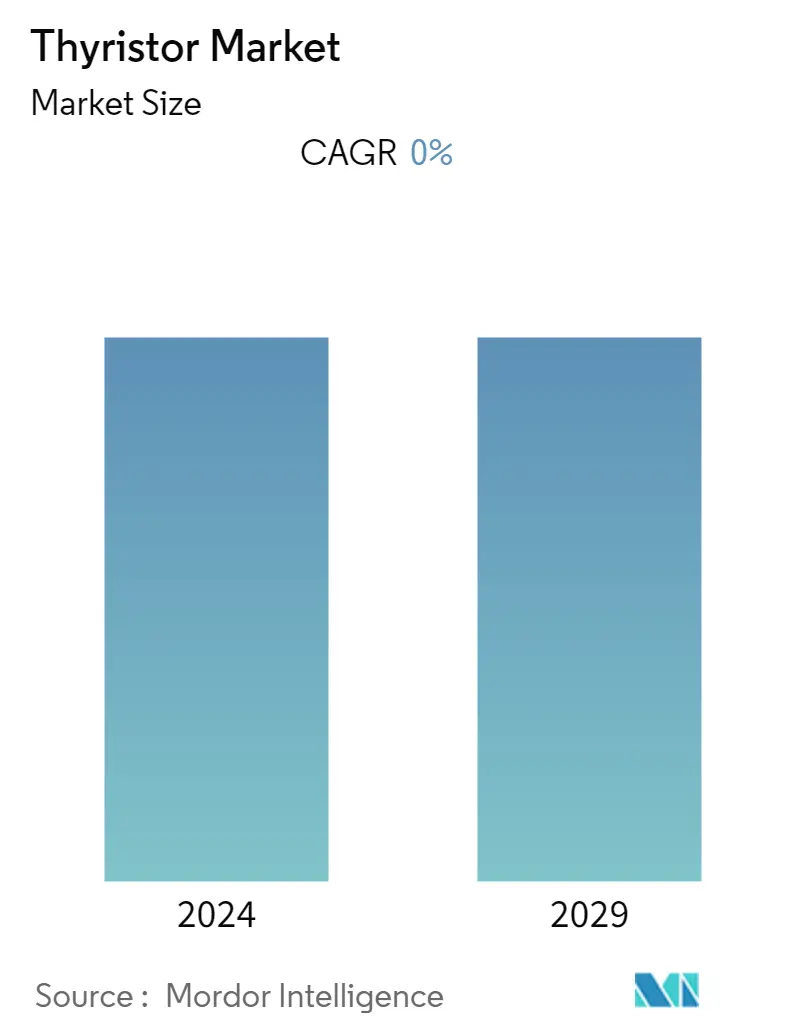
| Study Period | 2019 - 2029 |
| Base Year For Estimation | 2023 |
| CAGR | 0.00 % |
| Fastest Growing Market | Asia-Pacific |
| Largest Market | North America |
| Market Concentration | High |
Major Players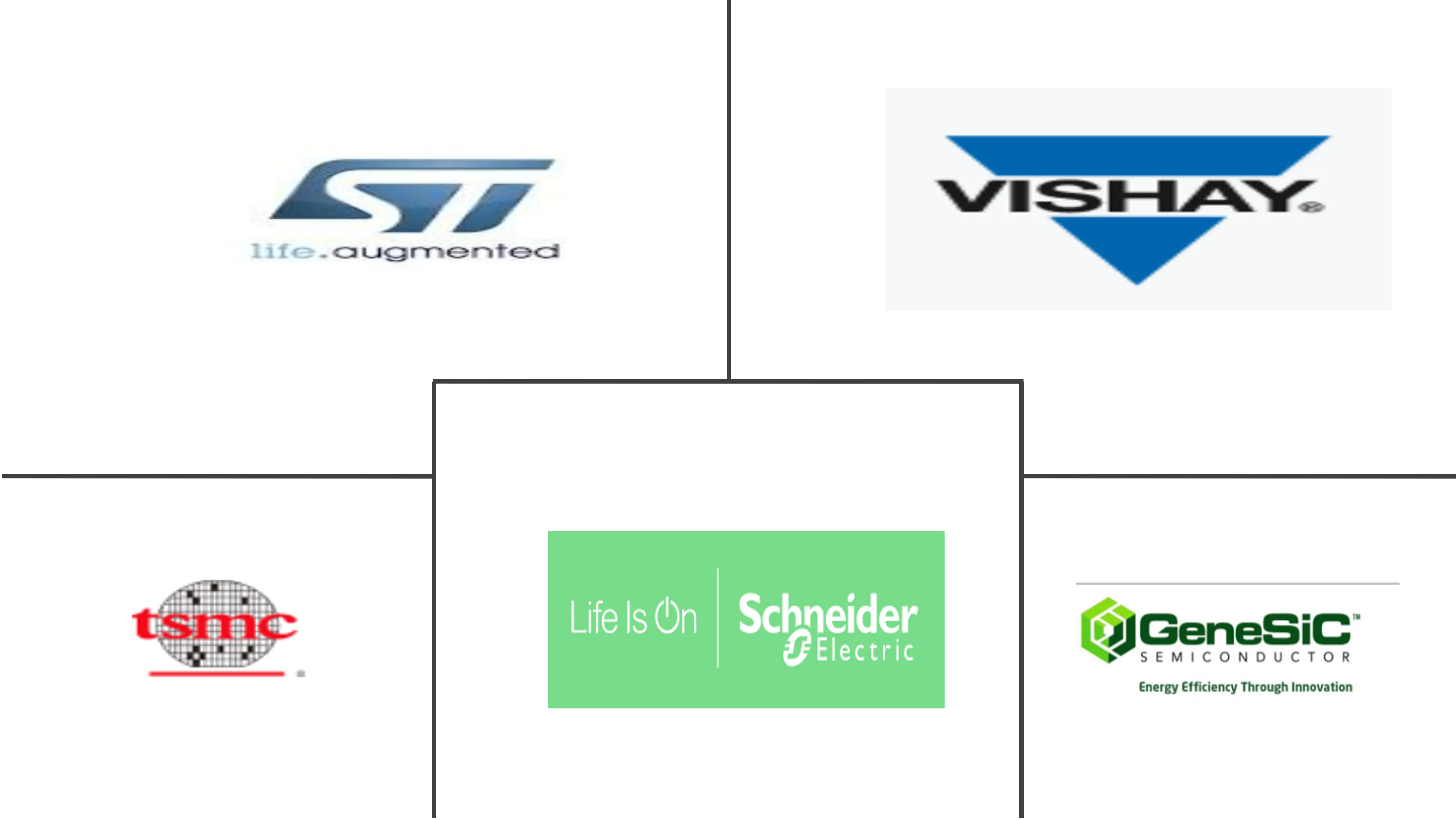
*Disclaimer: Major Players sorted in no particular order |
Thyristor Market Analysis
The thyristor market is expected to witness a CAGR of 4.7% during the forecast period (2022 - 2027). The thyristor market is witnessing significant growth attributed to replacing aging power infrastructure, particularly in developed economies. In addition, the increasing deployment of smart grids is further expected to foster market growth. Thyristors are integrated into power electronics such as controllers, inverters, and power supplies to fulfill the demand for solid-state switching devices. Some of the significant factors influencing the market's growth are:
- Electricity demand is constantly increasing in developing economies due to the rising population. Thyristors are used for low switching losses and short switching times of metal-oxide-semiconductor field-effect transistor (MOSFET) to meet current electricity demands. Thus, they are highly in demand across developing economies.
- Moreover, In India, the monthly electricity demand in 2022 is expected to peak at around 132 billion kWh, 15% higher than the average monthly demand, similar to 2021 and 2019, when peak monthly demand was 15% and 19% higher, respectively than average monthly demand. Pandemic-related lockdowns dampened demand in 2020, but peak monthly demand was 6% higher than average monthly demand.
- However, the high cost of infrastructure deployment is impeding the market growth. Furthermore, the declining deployment of turbines and PV and the development of high-speed trains pose a significant challenge to the market.
- The coronavirus pandemic has disrupted the global production and supply chain system (COVID-19), negatively impacting the thyristor market. Most industrial managers and policymakers look for appropriate strategies and policies to restructure production patterns and meet consumer demand. Mainly the raw materials are imported from China and other Asian developing countries from the global supply chain standpoint. The COVID-19 pandemic has disrupted most transportation and distribution links between suppliers, manufacturing facilities, and customers.
Thyristor Market Trends
This section covers the major market trends shaping the Thyristor Market according to our research experts:
Increasing Demand for Thyristor in Power Industry
- Thyristor modules play a vital role in power applications, owing to their low statistical failure rate. Thyristor modules are primarily used in the power industry to convert electrical energy from one form to another for various electrical applications.
- A thyristor module provides wide-range voltage control efficiently and cost-effectively by utilizing an optimal combination of on-load tap-changers and saturable reactors. Thyristor rectifier systems provide smooth step-less control via thyristor gate control from zero to the rated voltage.
- The growing use of thyristors in automobile ignition systems has also contributed to the market's expansion. In 2021, the global automotive industry will grow by double digits. Following an 18% drop in 2020, new car sales will increase by 15% in 2021. Commercial vehicle sales will rise by 16% in 2021, following a 16% drop in 2020.
- Thyristors are used in power supplies for digital circuits as a kind of "circuit breaker" or "crowbar" to prevent a power supply failure from damaging downstream components. Moreover, manufacturers of thyristor modules are continually engaged in developing such components.
- Due to these factors, demand for thyristor modules for long-distance power transmission is growing, with an increase in investment by various governments across the globe, which is expected to drive the global thyristor module market during the forecast period. Moreover, technologically advanced thyristor modules for various electrical uses. Thus, increasing focus on developing thyristor modules in the power industry is expected to bolster the market's growth.
- Additionally, thyristors have been used as lighting dimmers in television, film, and theatre for decades, replacing inferior technologies such as autotransformers and rheostats. They have also been used in photography as an important component of flashes (strobes).
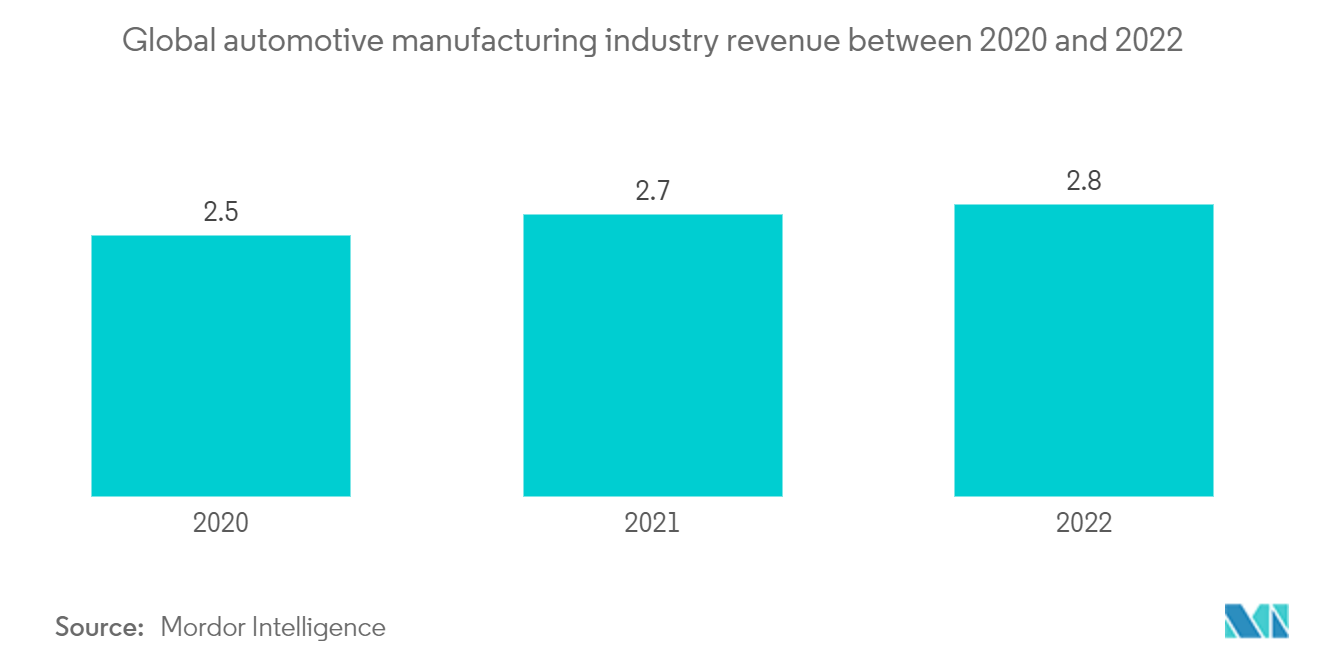
Asia-Pacific is Fastest Growing Region for the Thyristor Market
- The global thyristor module market has been segmented into North America, Europe, Asia Pacific, Middle East & Africa, and Latin America. Because of the large number of thyristor module manufacturers in Asia-Pacific, it is the fastest-growing market for thyristors. Furthermore, many well-established players are focusing on technological advancements in semiconductor products, which will further boost the growth of the region's thyristors market during the forecast period.
- Asia-Pacific is anticipated to dominate the global thyristor module market throughout the forecast period, as many manufacturers of thyristor modules operate in the region. Additionally, due to the growing opportunity, many well-established players from the Asia Pacific region are focusing on technological advancement in semiconductor products, which is expected to boost the thyristor module market in the region during the forecast period.
- The increasing adoption of HDVAC in developing countries is also boosting the thyristors market. For example, according to Powerline Magazine, India is focusing on direct high-voltage current (HVDC) transmission systems because they allow electricity to be transmitted over long distances with minimal loss. Currently, HVDC transmission lines account for 4% of total transmission line length. Additionally, in 2020, India's predominant voltage type of electricity transmission line is 400 kV, accounting for 43% of the total line length. With 42%, it is followed by 220 kV transmission lines.
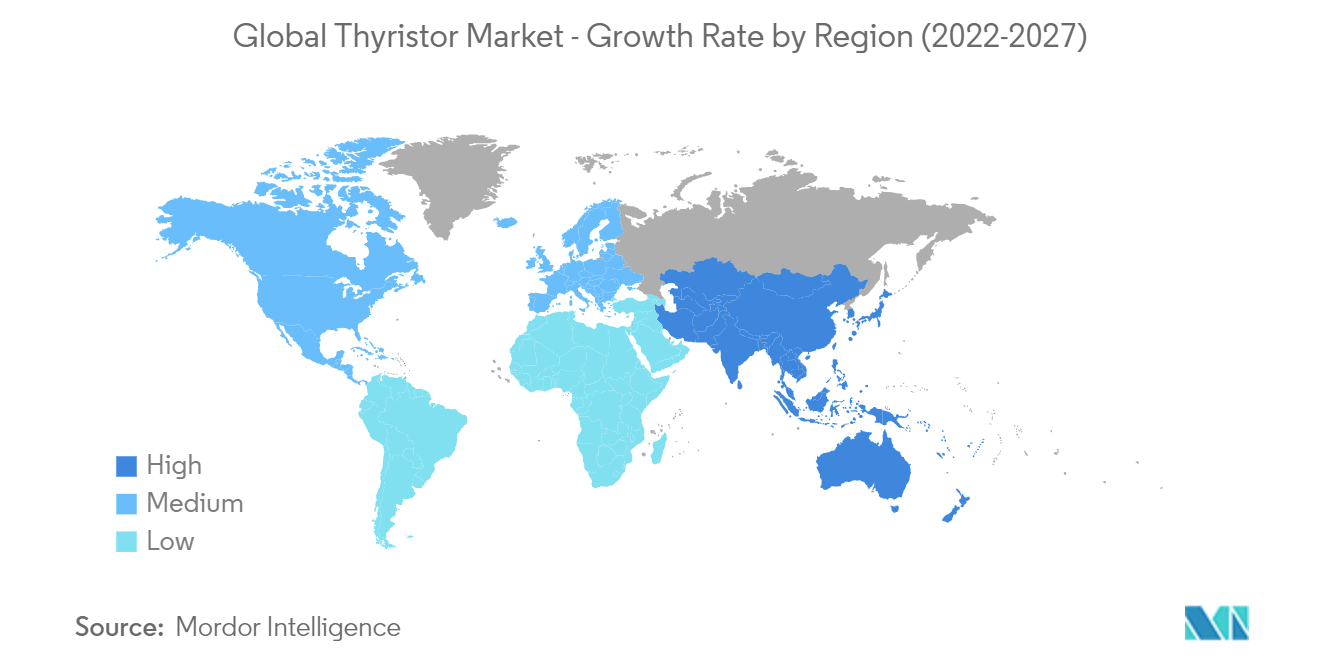
Thyristor Industry Overview
The Thyristor Market is highly fragmented owing to the various key players in the market. Various players are operating in the global market and are majorly focusing on the new technological advancements and expansions to meet the increasing demand for thyristor modules. In addition, manufacturers are entering into partnerships for the development of innovative products.
- May 2021, New BiPolar power modules featured industry-standard housings, the lowest losses, and the highest operating temperatures. The 60Pak module family provides the ultimate reliability and is the epitome of quality. It features the lowest losses and highest operating temperatures in industry-standard housing. Failure is not an option, whether efficiently driving industrial motors, smoothly controlling fans and pumps, or supplying power to demanding applications. These new products wrap up Hitachi Energy's best-quality products in standard industrial housing, delivering the highest performance, outstanding reliability, and increased overload capability.
Thyristor Market Leaders
-
STMicroelectronics
-
Vishay Intertechnology
-
Schneider Electric
-
TSMC
-
Sensata Technologies
*Disclaimer: Major Players sorted in no particular order
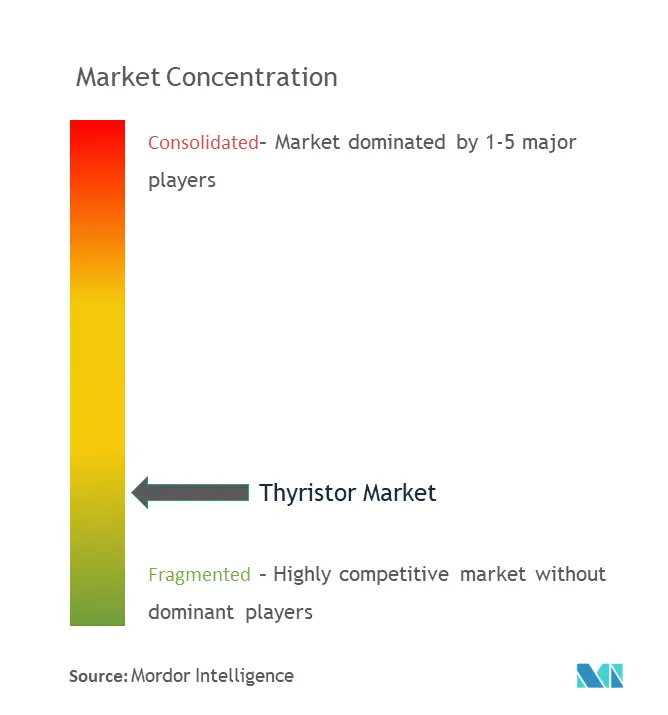
Thyristor Market News
- October 2020-Proton-Electrotex announced the launch of a new thyristor and thyristor-diode modules МТ3-700-18-А2 with increased power density. This module is based on its predecessor МТ3-540-18-А2. The higher power density was achieved by upgrading the semiconductor element with minimal changes to other design elements. Specifically, the module was designed with a new topology increasing the active cathode area by 10%, reducing the thickness of the diffusion element, and improving the diffusion profile.
Thyristor Market Report - Table of Contents
1. INTRODUCTION
- 1.1 Study Assumptions and Market Definition
- 1.2 Scope of the Study
2. RESEARCH METHODOLOGY
3. EXECUTIVE SUMMARY
4. MARKET INSIGHTS
- 4.1 Market Overview
- 4.2 Industry Value Chain Analysis
-
4.3 Industry Attractiveness - Porter's Five Forces Analysis
- 4.3.1 Bargaining Power of Suppliers
- 4.3.2 Bargaining Power of Consumers
- 4.3.3 Threat of New Entrants
- 4.3.4 Intensity of Competitive Rivalry
- 4.3.5 Threat of Substitutes
- 4.4 COVID-19 Impact on the Market
5. MARKET DYNAMICS
-
5.1 Market Drivers
- 5.1.1 Adoption of electric motors in industrial, commercial, and residential applications
- 5.1.2 Growing inclination toward use of electric and hybrid electric vehicles
-
5.2 Market Restraints
- 5.2.1 High infrastructure development cost and lack of technology awareness
6. MARKET SEGMENTATION
-
6.1 By Power Rating
- 6.1.1 500 MW
- 6.1.2 500 MW-1000 MW
- 6.1.3 1000 MW
-
6.2 By Application Industry
- 6.2.1 Consumer Electronics
- 6.2.2 Telecommunication & Networking
- 6.2.3 Industrial
- 6.2.4 Automotive
- 6.2.5 Aerospace & Defense
- 6.2.6 Others
-
6.3 By Geography
- 6.3.1 North America
- 6.3.2 Europe
- 6.3.3 Asia-Pacific
- 6.3.4 Latin America
- 6.3.5 Middle-East and Africa
7. COMPETITIVE LANDSCAPE
-
7.1 Company Profiles
- 7.1.1 STMicroelectronics
- 7.1.2 Vishay Intertechnology
- 7.1.3 Schneider Electric
- 7.1.4 Central Semiconductor
- 7.1.5 GeneSiC Semiconductor
- 7.1.6 TSMC
- 7.1.7 WeEn Semiconductor
- 7.1.8 Diodes Incorporated
- 7.1.9 Sensata Technologies
- 7.1.10 Shindengen Electric
- *List Not Exhaustive
8. INVESTMENT ANALYSIS
9. FUTURE OF THE MARKET
** Subject To AvailablityThyristor Industry Segmentation
Thyristors are semiconductor devices with four layers of alternating P-type and N-type materials. It comes in three categories: anode (positive terminal), cathode (negative terminal), and gate (control terminal). A thyristor, a semiconductor device with four layers of alternating P- and N-type materials, acts exclusively as a bistable switch, conducting when the gate receives a current trigger and continuing to conduct until the voltage across the device is reversed biased or until the voltage is removed.
| By Power Rating | 500 MW |
| 500 MW-1000 MW | |
| 1000 MW | |
| By Application Industry | Consumer Electronics |
| Telecommunication & Networking | |
| Industrial | |
| Automotive | |
| Aerospace & Defense | |
| Others | |
| By Geography | North America |
| Europe | |
| Asia-Pacific | |
| Latin America | |
| Middle-East and Africa |
Thyristor Market Research FAQs
What is the current Thyristor Market size?
The Thyristor Market is projected to register a CAGR of 0% during the forecast period (2024-2029)
Who are the key players in Thyristor Market?
STMicroelectronics, Vishay Intertechnology, Schneider Electric, TSMC and Sensata Technologies are the major companies operating in the Thyristor Market.
Which is the fastest growing region in Thyristor Market?
Asia-Pacific is estimated to grow at the highest CAGR over the forecast period (2024-2029).
Which region has the biggest share in Thyristor Market?
In 2024, the North America accounts for the largest market share in Thyristor Market.
What years does this Thyristor Market cover?
The report covers the Thyristor Market historical market size for years: 2019, 2020, 2021, 2022 and 2023. The report also forecasts the Thyristor Market size for years: 2024, 2025, 2026, 2027, 2028 and 2029.
Thyristor Industry Report
Statistics for the 2024 Thyristor market share, size and revenue growth rate, created by Mordor Intelligence™ Industry Reports. Thyristor analysis includes a market forecast outlook to 2029 and historical overview. Get a sample of this industry analysis as a free report PDF download.



